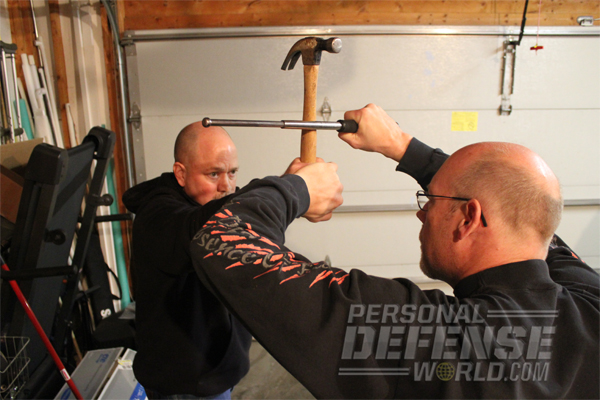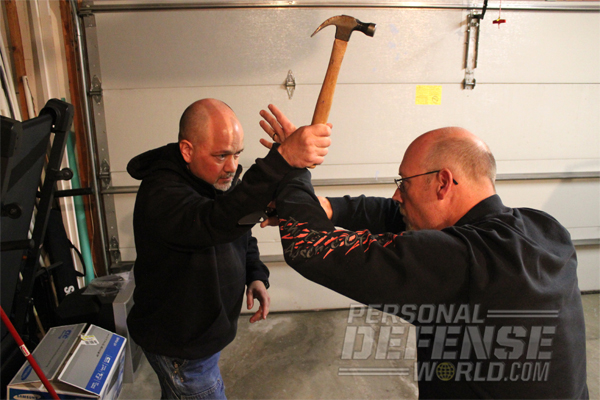Anyone who has trained in personal defense skills for any length of time knows that there is no “perfect” technique that works for every situation. However, there are some techniques that are versatile enough to be adaptable against many different types of attacks. The “roof block” of the Filipino martial arts is one such tactic, and one that I strongly believe belongs in everyone’s defensive toolbox. In simple terms, the roof block is a structure that combines a horizontal block or cut with a weapon with a simultaneous block with the non-weapon hand. When performed with a stick or long-bladed weapon, the body of the weapon resembles the ridge of a roof, giving the technique its name. Although it is most often used to defend against overhead attacks, the versatility of this structure allows it to be easily angled to one side or the other, making it effective against a broad range of high-line attacks.
“The roof block is a highly adaptable, combat-tested technique ideally suited to small-knife tactics.”
“The roof block is a highly adaptable, combat-tested technique ideally suited to small-knife tactics.”
BIG BLADE VERSION:
The most commonly taught form of the roof block is that seen in Filipino-style stick fighting, although similar tactics can also be found in many systems of Western fencing. This version is a weapon-to-weapon tactic that involves raising your stick or blade above your head with the body of the weapon horizontal so it’s perpendicular to the path of your attacker’s weapon. At the same time, you use the palm of your live (non-weapon) hand, thumb-side down, to check the attacker’s weapon-wielding hand. To achieve the greatest structural strength and best protect your head, both your hands should drive upward and at a forward angle of about 60 degrees to vertical. Very importantly, both your live hand and your weapon should do the work, making solid contact and stopping the strike cold. When applied with a sword or other large blade, use the thumb of your weapon hand to rotate the weapon 90 degrees in your hand. Instead of the edge making contact with the attacker’s weapon, the flat of the blade will make contact. This prevents damage to your edge and increases the surface area of the impact to better absorb the shock.
Advertisement — Continue Reading Below
SMALL BLADE VERSION:
Small knives don’t have enough mass or surface area to block a committed attack, so executing a roof block with a small-bladed weapon has to take another form. In the small-blade version of the roof block, the live hand—or more correctly, the forearm of the non-weapon hand—does all the blocking, making contact with the attacker’s forearm. At the same time, you use your knife to cut the forearm of the attacker’s weapon-wielding arm, hopefully compromising his grip or disarming him. My preferred method of executing a roof block with a small knife is to drive your blocking arm upward at about a 60-degree angle. Your hand should be open and your wrist slightly bent so the plane of your palm is parallel to your centerline and your hand is about 8-10 inches above your forehead. In this position, your elbow will be slightly bent, but the skeletal structure of your arm will be very strong. Your knife hand should be positioned immediately below the hand of your blocking arm. It should be palm-down so the blade is horizontal and facing edge forward. For best results, the back of your knife hand should contact the ulnar (pinky side) of the wrist of your blocking arm.
CLICK HERE for Self-Defense & The Law!
As the attack descends, step forward and drive both hands upward and forward so the back of your blocking forearm intercepts the attacker’s forearm near the wrist. As you make contact, immediately pull your blade across the attacker’s forearm with a backhand motion. At the same time, move your blocking arm outward as well. This simultaneous “opening” motion of both arms creates a shearing effect and guides the attacker’s weapon away from your head. Care should be taken, however, not to sacrifice the solid structure of the block for “timed” opening of the arms. While some styles prefer this “umbrella block” approach, it is harder to learn and less reliable than the roof block—especially when executed with a small knife. To finish the fight after the roof block, use the palm of your live hand to collect the attacker’s elbow and pull his arm under your armpit to control it. Continue the flow of your first cut to bring the blade down vertically onto the top of the attacker’s arm. Drop your weight and pressure cut through the bicep and brachial nerve plexus, then follow immediately by cutting the quadricep muscle to disable his leg. With practice, this sequence can disable the attacker’s weapon-wielding arm and one of his legs in slightly more than a second. The roof block is a highly adaptable, combat-tested technique ideally suited to small-knife tactics. It’s a worthwhile addition to your defensive skill set.
Advertisement — Continue Reading Below

























